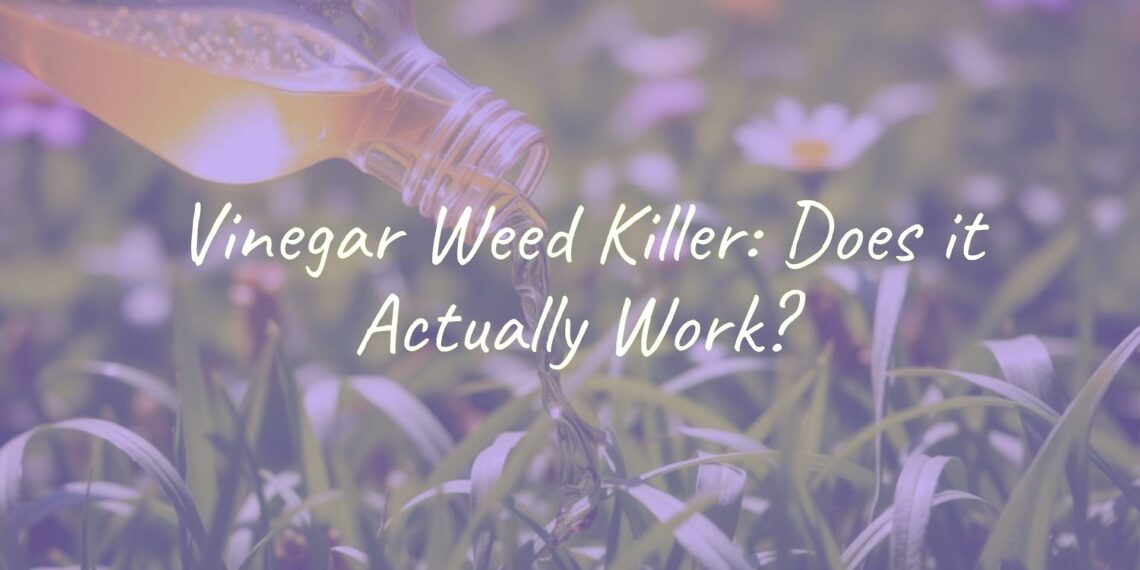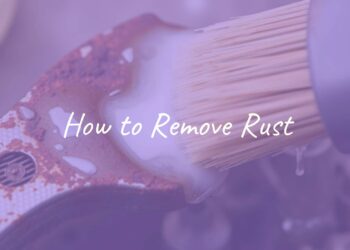Dealing with weeds growing through cracks or among your favorite plants is a common struggle for many gardeners. While there are plenty of commercial products that claim to quickly get rid of weeds, a more natural and eco-friendly option is sitting right in your kitchen: vinegar. But does vinegar really work as a weed killer? For the most part, yes-vinegar can help control unwanted weeds, especially certain types and in certain locations. The secret is acetic acid, the active part of vinegar, which works as a natural weed killer. Like any gardening tool, though, it has its own set of benefits and downsides that you need to know in order to use it well and safely.

What is a vinegar weed killer?
A vinegar weed killer is a homemade or store-bought mix that relies on acetic acid, found in vinegar, to dry out and kill plants. Unlike conventional weed sprays that use synthetic chemicals, vinegar solutions appeal to folks interested in using simple and often safer ways to manage weeds. Regular kitchen vinegar contains about 5% acetic acid, but some special gardening vinegars (called horticultural vinegars) have much higher levels-sometimes 20%, 30%, or even 45%. These stronger kinds are much more effective against stubborn or mature weeds.
Vinegar is easy to get and many people think it’s safer than regular herbicides. Those who want to avoid using too many chemicals at home enjoy using something as straightforward as vinegar. This matches the growing interest in natural garden care and lets gardeners tackle weeds without using harsh sprays.
How does vinegar kill weeds?
Vinegar weed killer works because of the acetic acid. This acid attacks the plant by breaking down its outer cells. Imagine the leaves and stems as tiny bags filled with water; when you apply vinegar, the acid makes these bags leak and collapse. The plant loses moisture quickly-essentially drying out so fast that the weed wilts and shrinks, often within hours if it’s warm and sunny. The key is that vinegar needs to touch the leaves and stems; it doesn’t usually travel down and harm deep roots. This means you may get quick results on the surface, but it may not stop some weeds from coming back if they have strong root systems.

Which types of weeds does vinegar work on?
Vinegar works best on small, young weeds-especially those just sprouting. These weeds have soft stems and shallow roots, so the acid dries them out quickly, and they die fast. Broadleaf weeds tend to be especially easy to target, since they have more leaf area for the vinegar to cover.
However, vinegar doesn’t work as well on old, deep-rooted perennials or thick grasses. Weeds like dandelions or thistles have tough roots, so the vinegar usually only kills the top part. The roots are likely to survive and regrow the visible part of the plant. In some cases, you’ll need to reapply vinegar several times, and you still might not get rid of the weed completely. Weeds with waxy or fuzzy leaves may also resist vinegar, but mixing in a drop of dish soap helps the solution stick better and cover the leaves thoroughly.
What are the ingredients in vinegar weed killer recipes?
A typical vinegar weed killer is easy to make and uses just a few things you probably already have at home. The main ingredient is vinegar, but other parts like dish soap and sometimes salt can make the mix work even better. Each ingredient plays a role-dish soap helps vinegar stick to the plant, and salt adds extra drying power. You can change the recipe a little depending on what weeds you’re fighting and where you’re using the mixture.

What kind of vinegar is best for weed control?
The most important thing when choosing vinegar for weeds is how much acetic acid it has. Regular white vinegar from the store has about 5%, which is good for small, young weeds, but isn’t always strong enough for tougher jobs. Horticultural vinegar is much stronger (20% and up) and can work on bigger, heartier weeds-even reaching their roots if applied a few times. The stronger the vinegar, the more careful you should be-high-concentration vinegar can hurt your skin, eyes, or lungs, so wear protection if you use it.
Should you add salt to vinegar weed killers?
Adding salt (plain table salt) can make your vinegar weed killer even more powerful because salt pulls water out of plant cells and dries them up. But be careful: salt also builds up in the soil, making it hard for anything, even your good plants, to grow there later. It can also hurt earthworms and helpful microbes. If you use salt in the mix, only use it on pavement cracks, driveways, or places where you never want anything to grow-not in flower beds or lawns.
Does dish soap improve weed killing effectiveness?
Yes, dish soap helps a lot! Dish soap acts like a spreading and sticking agent-it breaks the surface tension on plant leaves so the vinegar doesn’t just bead up and roll away. Just a little bit helps vinegar (and salt, if used) stick to the leaves, making sure the weed gets a good dose. Any liquid dish soap will do, although some gardeners like to use brands like Dawn. This small step can make your homemade solution much more effective.
How to make a vinegar weed killer solution
Making your own vinegar weed killer is simple and doesn’t take much time. It’s important to gather all your supplies first and use caution if you’re working with strong vinegar. Making it yourself means you can control what goes in and avoid harmful chemicals.
Materials needed
- Vinegar: One gallon of white vinegar (5% acetic acid) for regular weeds or horticultural vinegar (20% or more) for tougher weeds. Higher strengths need extra care when handling.
- Dish Soap: 1 tablespoon liquid dish soap helps the mixture stick to leaves.
- Salt (Optional): 1 cup regular table salt-only for use where you want nothing to grow in the future.
- Large Mixing Bucket or Container: For combining all the ingredients.
- Spray Bottle or Garden Sprayer: To apply the mixture to weeds-use a sprayer for large areas, or a bottle for small spots.
- Protective Gear: Gloves (and eye protection for strong vinegar) to protect your skin and eyes from irritation.
Step-by-step recipe
- Mix Vinegar and Salt: Pour 1 gallon of vinegar into your container. Add 1 cup salt (if using) and stir until fully dissolved-this prevents clogging your sprayer.
- Add Dish Soap: Stir in 1 tablespoon dish soap. Don’t mix too hard, or you’ll get lots of bubbles.
- Transfer the Solution: Pour your mixture into your spray bottle or garden sprayer.
- Shake Before Use: Shake the container each time before spraying to keep the solution mixed.
Safe storage tips
- Use the Right Containers: Store leftover mixture in a tightly closed, labeled container-original vinegar bottles work well. Don’t leave it sitting in your sprayer for too long, as vinegar can wear down the sprayer’s rubber parts.
- Label Clearly: Make sure your storage container is labeled (e.g., “Vinegar Weed Killer”) and dated to avoid confusion.
- Store in a Cool, Dark Place: Keep the solution away from direct sunshine or hot areas to keep it stable.
- Keep Away from Children and Pets: Even though the ingredients seem harmless, higher-strength vinegar can irritate skin and eyes. Store it safely.
- Don’t Store Near Food: Keep your weed killer away from food and don’t use containers that might look like something you’d drink from.
How to use vinegar weed killer effectively
Spraying vinegar weed killer is easy, but using it the right way is important if you want the best results. You need to spray at the right time, in the right way, and on the right kinds of weeds. If you’re careful and pay attention, you can kill weeds without hurting your other plants.

Application methods and timing
The best time to spray is on a sunny, warm day (at least 70°F). Sun helps the vinegar dry out the plants faster. Early morning or late afternoon is a good choice to avoid the heat of midday, when the solution could evaporate too quickly to work. Don’t spray on windy days; the spray can drift to plants you want to keep. Pick a day with no rain expected for at least 24 hours so the vinegar has time to work. Spray directly onto the weed’s leaves and stems-don’t just spray everywhere. For tricky spots or close to other plants, use cardboard or your hand (with a glove) to shield the good plants, or use a brush to paint the vinegar right where you want it.
How long does vinegar take to kill weeds?
Vinegar often works quickly-you can see wilting and browning in just a few hours if it’s sunny. Usually by the next day, the weeds look much worse. For small, young weeds, one treatment may be all you need. For bigger or perennial weeds, the tops will die but the roots might survive, so you might have to reapply several times to finally wear the weed out.
How to protect grass and nearby plants
Vinegar doesn’t know the difference between weeds and your prized flowers or grass-it will damage whatever it touches. Here’s how to keep your good plants safe:
- Use Precise Spraying: Use a bottle with a narrow spray setting, and get close to the weed.
- Put Up Barriers: Use cardboard, plastic, or even your hand (with a glove) to shield other plants while spraying.
- Brush Application: For weeds right next to valuable plants, use a paintbrush to dab vinegar directly on the weed.
- Spray Only on Calm Days: Wait for a day with no wind to avoid drifting spray.
- Avoid Salt Near Plants: Don’t use salt mixes near roots or soil you want to keep healthy.
Risks and limitations of vinegar weed killers
Although vinegar is considered a “natural” weed killer, it’s not perfect and can create problems if not used wisely. You shouldn’t expect it to always give the same results as store-bought chemicals, especially for hard-to-kill, deep-rooted weeds or large weedy areas.

Will vinegar kill weeds permanently?
Vinegar can get rid of small or young weeds pretty well, but don’t expect it to remove tough, perennial weeds for good. It only kills what you see above ground. Roots of many weeds will just grow new leaves after a while. You’ll probably need to spray again several times over a season to keep weeds down. Stronger horticultural vinegar can sometimes help with more stubborn plants after several uses, but rarely solves the problem forever in one go.
Possible drawbacks and plant damage
Vinegar weed killer has a few important downsides. First, it’s non-selective-it kills or injures any plant it touches, including your garden and lawn plants. Drift or overspray can easily brown or kill areas you didn’t mean to treat. Strong vinegar can also damage nearby plants just from the fumes. Salt, if used, can make soil unsuitable for future planting. Horticultural vinegar (the strong stuff) can burn your skin and eyes and should always be handled with gloves and eye protection.
Can vinegar affect soil health?
Yes, especially if you use it often or in large amounts. Vinegar lowers soil pH, making it more acidic. Some plants don’t mind, but many will not grow well in acidic soil. Lowering the pH too much can harm helpful microbes and earthworms. If you add salt, this causes even more trouble-salt can stay in the soil and stop anything from growing for a long time. That’s why it’s best to use vinegar weed killers only in places where you don’t care about keeping the soil healthy for future planting.
When to choose horticultural vinegar or store-bought alternatives
Comparing household and horticultural vinegar
| Type | Acetic Acid % | Best Use | Safety |
|---|---|---|---|
| Household White Vinegar | 5% | Small, young weeds | Generally safe, but gloves advised |
| Horticultural Vinegar | 20-45% | Tough, mature weeds | Caustic-wear gloves, goggles, and long sleeves |
Horticultural vinegar is much stronger and works better on tough jobs, but you need to be especially careful when handling it. It usually costs more and should always be kept away from children and pets.
When to use commercial weed killers instead
- If you have a large area of weeds (like a whole lawn or field).
- If you’re dealing with deep-rooted or highly invasive weeds that keep coming back.
- If the weed has waxy or hairy leaves that vinegar can’t easily penetrate.
- If weeds are growing among plants you want to keep and precise spraying is impossible.
Store-bought weed killers might be faster, more effective, or less work for these cases. Always follow label instructions when using any commercial product.
Frequently asked questions about vinegar weed killers
How long does vinegar prevent weeds from regrowing?
Vinegar usually gives short-term results. For small annual weeds, it may kill them completely if you spray early enough. But for perennials or tough weeds, the effect doesn’t last-the visible part might die, but the root usually survives and sends up new shoots after a few weeks. Strong horticultural vinegar can slow some weeds for longer, but repeat treatments are often needed for lasting control.
Is homemade weed killer safe for pets?
Homemade weed killer with regular vinegar and no salt is generally safer for pets and kids than many chemical sprays once it dries. Be careful with strong vinegar (20% or more)-it can burn skin and is risky if swallowed. If you add salt, keep pets away, as salt is not safe for them to eat. Always let areas dry completely before letting animals or children back. Store leftover solution safely out of reach.
Can you use vinegar weed killer on lawns?
No-you should not spray vinegar weed killer on your grass. It will kill whatever it touches, turning patches of lawn brown and dead. Salt will make this worse by damaging the soil. Save vinegar solutions for pavement cracks, paths, or fence lines-anywhere you don’t want plants to grow. For lawn weeds, pull by hand, use spot treatments of selective lawn herbicides, or improve your lawn’s health to crowd weeds out.
















![What to with Scrap Metal? [infographic]?](https://facts-homes.com/wp-content/uploads/2019/07/645413-POPYOV-391-120x86.jpg)





